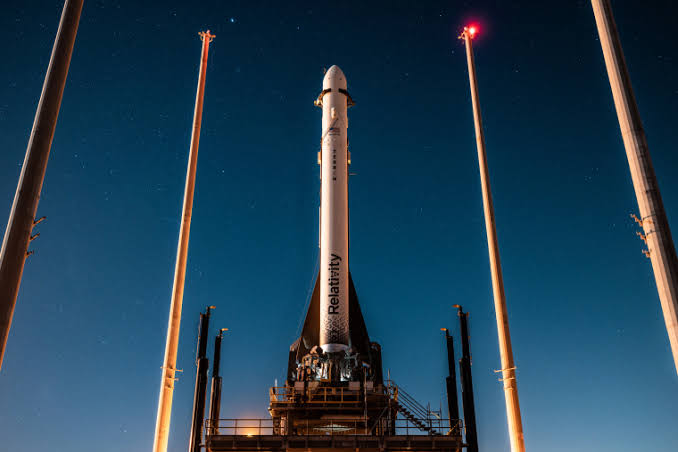Aerospace manufacturing has changed as a result of 3D printing technology, which offers advantages like lower production costs, more design flexibility, and quicker turnaround times. With the advent of 3D printing, inventive and distinctive rocket designs are now feasible. Additionally, future space research missions might be able to produce entire rockets or replacement parts thanks to the on-demand manufacturing capabilities of 3D printing.
Relativity’s Terran 1:
The first 3D-printed rocket in the world, Terran 1, is getting ready for its inaugural flight. The rocket, which won’t launch with a payload on its initial flight, can eventually lift 2,755 pounds (1,250 kilogrammes) into low Earth orbit.
The rocket has a diameter of 7.5 feet (2.2 metres), a height of 110 feet (33.5 metres), and 85% of its bulk is made up of metal alloys that were 3D printed. This contains the first stage’s nine Aeon 1 engines and the second stage’s single Aeon Vacuum engine.
The rocket was created using the largest 3D metal printers in the world, according to the Long Beach-based business that created it. This advancement in rocket production has the potential to revolutionise the aerospace sector and open the door for more economical and effective rocket designs.
Greater design flexibility and lower production costs are made possible by the use of 3D printing technology in the manufacture of rockets, which may make space travel more accessible and inexpensive in the future. The accomplishment of Terran 1’s first flight will mark a significant turning point in this project and will demonstrate the potential of 3D printing in aeronautical innovation.
The Launch:
A more affordable and cutting-edge spacecraft, the first 3D printed rocket in the world is about to launch on its third attempt. The Terran 1 spacecraft, developed by California-based startup Relativity Space, has previously experienced technical issues, but the business is certain that this time will be the third time’s the charm.
Prior launch attempts of the rocket were postponed because of fuel pressure and propellant temperature difficulties. With a three-hour launch window starting on Wednesday at 10:00 pm Eastern Time, Relativity Space remains upbeat about the approaching launch, nevertheless.
The launch of Terran 1 will be a crucial turning point in proving the usefulness of 3D-printed rockets in the aerospace sector. On its initial launch, the rocket will be empty of payload; nevertheless, once fully operational, the inventive spacecraft can transport up to 2,755 pounds (1,250 kilogrammes) of payload.
The rocket’s use of methane fuel is also novel, and if it is successful, it will be the first privately sponsored methane-fueled spacecraft to successfully enter low Earth orbit. The journey of Terran 1 will gather useful information and demonstrate the resilience of 3D-printed rockets in the face of the demands of spaceflight.
The Engineering of Terran 1:
A rocket that is 95% 3D printed is Relativity Space’s lofty objective; achieving it will save costs and revolutionise the sector. Liquid oxygen and liquid natural gas, which are hailed as the “propellants of the future” and have the potential to power a voyage to Mars, are used as propellants in the Terran 1 rocket.
The Terran R rocket, being developed by Relativity Space, is bigger and entirely reusable and has a payload capacity of 44,000 pounds (20,000 kg) for low-Earth orbit missions. The Terran R’s debut launch is anticipated for the following year.

The company’s 3D-printed rockets can be built from raw materials in just 60 days and have 100 times fewer parts than conventional rockets. It can take years to get a slot on an Arianespace or SpaceX rocket, therefore Relativity Space wants to speed up the process.
According to CEO Tim Ellis, Relativity Space has landed $1.65 billion worth of commercial launch contracts, the majority of which are for Terran R. The company’s goal of using 3D printing technology to completely alter the aerospace sector will be advanced by the success of Terran 1’s first flight.
Recent post: NASA Reveals Brand New Spacesuit For Artemis III Moon Mission
Conclusion:
The emergence of 3D-printed rockets, which provide a more affordable and environmentally friendly alternative to conventional rocket manufacture, marks a fundamental shift in the aerospace sector. Leading companies in this industry, like Relativity Space, are creating rockets that are reusable, primarily 3D printed, and employ cutting-edge propellants like liquid oxygen and liquid natural gas.
In the upcoming years, we may anticipate more fascinating advances and advancements in the field of space exploration as they continue to innovate and push the limits of what is possible. The revolutionary technology of 3D printing is making space travel more feasible and promising than ever before.
